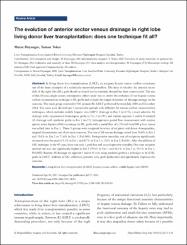| dc.contributor.author | Dayangaç, Murat | |
| dc.contributor.author | Tokat, Yaman | |
| dc.date.accessioned | 2016-05-16T12:16:19Z | |
| dc.date.available | 2016-05-16T12:16:19Z | |
| dc.date.issued | 2016 | |
| dc.identifier.citation | Dayangac M, Tokat Y. The evolution of anterior sector venous drainage in right lobe living donor liver transplantation: does one technique fit all? Hepatobiliary Surg Nutr. 2016;5(2):151-158. doi: 10.3978/j.issn.2304-3881.2015.08.01. | en_US |
| dc.identifier.issn | 2304-389X | |
| dc.identifier.uri | http://hbsn.amegroups.com/ | en_US |
| dc.identifier.uri | https://hdl.handle.net/11446/962 | en_US |
| dc.description | İstanbul Bilim Üniversitesi, Tıp Fakültesi. | en_US |
| dc.description.abstract | In living donor liver transplantation (LDLT), an adequate hepatic venous outflow constitutes one of the basic principles of a technically successful procedure. The issue of whether the anterior sector (AS) of the right lobe (RL) graft should or should not be routinely drained has been controversial. The aim of this 10-year, single-center, retrospective cohort study was to review the evolution of our hepatic venous outflow reconstruction technique in RL grafts and evaluate the impact of routine AS drainage strategy on the outcome. The study group consisted of 582 primary RL LDLT performed between July 2004 and December 2014. The cases were divided into 3 consecutive periods with different AS venous outflow reconstruction techniques, which included middle hepatic vein (MHV) drainage in Era 1 (n=119), a more selective AS drainage with cryopreserved homologous grafts in Era 2 (n=391), and routine segment 5 and/or 8 oriented AS drainage with synthetic grafts in Era 3 (n=72). Intraoperative portal flow measurement with routine splenic artery ligation (SAL) technique (in RL grafts with a portal flow of ≥ 250 mL/min/100 g liver tissue) was added later in Era 3. These 3 groups were compared in terms of recipient and donor demographics, surgical characteristics and short-term outcome. The rate of AS venous drainage varied from 58.8% in Era 1 and 35.0% in Era 2 to 73.6% in Era 3 (P<0.001). Perioperative mortality rate of recipients significantly decreased over the years (15.1% in Era 1 and 8.7% in Era 2 vs. 2.8% in Era 3, P=0.01). After the addition of SAL technique in the 45 cases, there was only 1 graft loss and no perioperative mortality. One-year recipient survival rate was also significantly higher in Era 3 (79.6% in Era 1 and 86.1% in Era 2 vs. 92.1% in Era 3, P=0.002). Routine AS drainage via segment 5 and/or 8 veins using synthetic grafts is a technique to fit all RL grafts in LDLT. Addition of SAL effectively prevents early graft dysfunction and significantly improves the outcome. | en_US |
| dc.language.iso | eng | en_US |
| dc.publisher | AME Publishing Company | en_US |
| dc.identifier.doi | 10.3978/j.issn.2304-3881.2015.08.01 | en_US |
| dc.rights | info:eu-repo/semantics/openAccess | en_US |
| dc.subject | living donor liver transplantation (LDLT) | en_US |
| dc.subject | hepatic venous outflow | en_US |
| dc.subject | middle hepatic vein (MHV) | en_US |
| dc.title | The evalution of anterior sector venous drainage in right lobe living donor liver transplantation: does one technique fit all? | en_US |
| dc.type | article | en_US |
| dc.relation.journal | Hepatobiliary surgery and nutrition | en_US |
| dc.department | DBÜ, Tıp Fakültesi | en_US |
| dc.identifier.issue | 2 | |
| dc.identifier.volume | 5 | |
| dc.identifier.startpage | 151 | |
| dc.identifier.endpage | 158 | |
| dc.contributor.authorID | TR216963 | en_US |
| dc.relation.publicationcategory | Belirsiz | en_US |


















